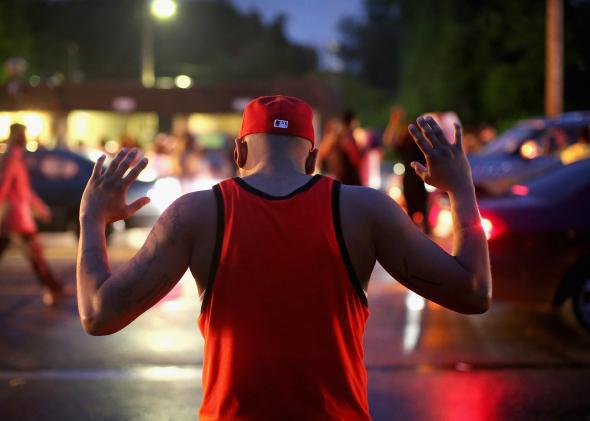What could become the biggest heat wave of the year for much of the eastern part of the country is gaining strength today. Urban parts of the St. Louis metro area, including Ferguson, Missouri, are expected to bear the brunt of it.
The heat is developing a day after impressive weather bombarded the St. Louis area. Here’s a quick look at what happened Wednesday night as a “ring of fire” round of storms rolled through:
It’s been a relatively mild summer this year for much of the Eastern and Central United States, including the St. Louis area, but that’s about to change. Thursday was the first day in the 90s there in more than two weeks, and the heat index is expected to reach well into the triple digits from Thursday through the end of the weekend.
The National Weather Service in St. Louis has issued an excessive heat warning, the highest tiered heat-related advisory:
…EXCESSIVE HEAT WARNING REMAINS IN EFFECT UNTIL 7 PM CDT SUNDAY…
* TIMING…DANGEROUS LEVELS OF HEAT AND HUMIDITY WILL CONTINUE FOR THE REST OF THE WEEK AND INTO THE UPCOMING WEEKEND.
* HEAT INDEX VALUES…UP TO 107 DUE TO TEMPERATURES IN THE 90S AND DEWPOINTS IN THE LOWER 70S.
* IMPACTS…THE COMBINATION OF HOT TEMPERATURES AND HIGH HUMIDITY WILL LEAD TO AN INCREASED RISK OF HEAT-RELATED STRESS AND ILLNESS. THE VERY YOUNG…THE ELDERLY…THOSE WITHOUT AIR CONDITIONING…AND THOSE PARTICIPATING IN STRENUOUS OUTDOOR ACTIVITIES WILL BE THE MOST SUSCEPTIBLE. ALSO…CAR INTERIORS WILL REACH LETHAL TEMPERATURES IN A MATTER OF MINUTES. BEAT THE HEAT…CHECK THE BACKSEAT! NEVER LEAVE CHILDREN OR PETS UNATTENDED IN A VEHICLE…NOT EVEN FOR A MINUTE.
And it’s not just St. Louis: The full-scale heat wave will affect much of the Southeast and push as far north as Minneapolis, Chicago, Washington, and New York City by Saturday.
New research this week by Climate Central shows that St. Louis has one of the worst urban heat islands in the country. In extreme cases, the city can be up to 17 degrees Fahrenheit hotter than the surrounding rural areas. On average, the urban heat island—which traps heat in the asphalt and buildings of urban cores that lack dense tree cover—gives the center of the St. Louis metro 19 additional days above 90 degrees Fahrenheit each year than the outskirts.
As Slate’s Jamelle Bouie has been reporting all week from Ferguson, there hasn’t really been a public space for protests there. By default, members of the community have congregated in parking lots, gas stations, and the street itself.
Temperatures of this scale are deadly, especially for those without a good way to cope. I asked a representative of St. Louis County whether Ferguson offers cooling centers during extreme heat days. Their computer system was down, but a search of the Missouri Department of Health and Senior Services database and another database she directed me to from the United Way shows that not a single cooling center is located in Ferguson.
In 1995, Chicago suffered through a catastrophic heat wave that has drawn comparisons to Hurricane Katrina. During that week in Chicago, 739 people died of heat-related causes. Author Eric Klinenberg blames that shocking toll on a “blend of extreme weather, political mismanagement, and abandonment of vulnerable city residents.”
Mary Hayden, a public health expert at the National Center for Atmospheric Research is in the final stages of a project designed to analyze vulnerability to heat stress in Houston. Her biggest finding so far? “Heat risk is exacerbated by poverty.” While that result may not be particularly surprising, Hayden said, “now we have the numbers to prove it.”
Via phone, she described her Houston research: “If you’re looking at just a central downtown area, it could be that those are just high-rise buildings where there are no people living. The centerpiece of our study is a 901-household survey on extreme heat vulnerability stratified by socioeconomic status. We wanted to find where residential areas coupled with urban heat islands, who lives there, and how they deal with the heat.”
Their work so far has revealed some shocking statistics. “The odds of not knowing the symptoms of heat stress are almost three times greater for those who make less than $30,000 a year,” she said. “In Houston, although the city reports that 99 percent of residents have air conditioning, not everyone can afford it. African-Americans are significantly more likely to have had trouble paying their electric bill, and 73 percent had no idea that there were special programs designed to help them.”
Her takeaway: “We’re not reaching that vulnerable population at all.”
So what should cities like Houston and St. Louis do to stem the expected increase in heat deaths in the coming decades? The answer, Hayden says, is to use this study to redouble efforts into community education. She proposes a partnership between television meteorologists and local public health departments to serve as a conduit of lifesaving information during heat waves.
Over the longer term, “community centers are absolutely the way to go.” In one building, Hayden says, a community center “provides a focal point. It can act as a cooling shelter, it’s crime reduction, it’s so many things.”
